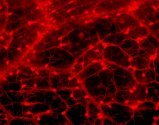
COBRE
Department of Ophthalmology
University of Oklahoma Health Sciences Center
HOME | PI | PJIs | CORES | MENTORS | IAC | EAC | SPOTLIGHT | SEMINARS | CALENDAR | AFFILIATES
Molecular Biology
Image Acquisition and Production
Animal Core
Lipid Analysis
ANIMAL CORE FACILITIES
The animal resources module director, Dr. James McGinnis, has served on the OUHSC campus IACUC (Institutional Animal Care and Use Committee) for the past 4 years and as Chairman of the DMEI, IACUC for the past three years. He has a working familiarity with USDA Animal and Plant Health Inspection Service regulations governing animal facilities. Gary L. White, D.V.M., M.M.S. is head of the Division of Laboratory Animal Medicine at OUHSC and has worked for the past 25 years as campus veterinarian and is the Veterinarian Consultant for our animal facilities. He visits and inspects the facility once a month and discusses day-to-day operations. The campus veterinarians are available on call 24 hours at day to attend sick animals and to consult. Mr. Mark Dittmar, L.A.C.T. has worked as a licensed animal care technician at the DMEI animal facility for over 15 years and is responsible for daily activities necessary for maintenance of all animals in the DMEI facility. Mark will supervise with the animal technician supported by the Animal Core of the COBRE.
In addition to maintaining the entire core facility, Mark also provides his expertise in the performance of experiments with the vision research investigators. Mark either does electroretinograms (ERG's) by himself, assists others or trains others to perform this technique which is routinely used to quantitatively evaluate the vision of rabbits, rats, mice and frogs. He is also responsible for all euthanasia procedures on rabbits and most of the adult rats and the dissection, collection and preservation of various tissues requested by the investigators. His time is now spent with about 75 % for direct animal care and maintenance and 25 % for assisting investigators in the performance of experiments. The Animal care person requested in the budget will assist in the care of additional animals and also free up some of Mark's time which will be made available to the PJI's. Mr. Dittmar will also teach the new technician how to do ERG measurements.
The animal resources facility is a 2,560 sq. ft. space located in the basement of the Dean A. McGee Eye Institute. The area consists of 6 animal rooms (3 mice; 2 rat; 1 rabbit; 1 general holding area), a surgical suite, a recovery room, a general procedures room, a cage cleaning/sterilization room, a food and bedding storage room, and a mechanical room. The entire animal facility was renovated in 1996-97. About 1200 mice will be housed in one room for the PJI's. This increases the number of mice to about 4000 by reassigning rooms and reducing the rabbits from 30 to 18. The current maximum capacity of the vivarium is to house 18 rabbits, 200 rats, and approximately 4000 mice at any one time. If a room becomes unusable due to contamination with microorganisms (even though this has not occurred in our experience), animals can be temporarily housed at the main campus facility while decontamination is in progress.
Equipment
The animal facility has purchased a "refurbished" large autoclave which accepts the cages used for all animals and a 30 year old "pass through" rack and cage washer (this will soon be replaced). In addition, there is a room and equipment for measuring the electroretinograms of rabbits, rats and mice.
Please send comments,
questions, or error reports to Holly-Whiteside@ouhsc.edu

Copyright © 2003-2012 The Board of Regents of the University of Oklahoma, All Rights Reserved
University of Oklahoma Disclaimers
Copyright © 2003-2012 The Board of Regents of the University of Oklahoma, All Rights Reserved
University of Oklahoma Disclaimers